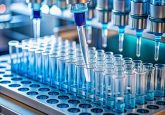Robotics and X-ray lasers for pioneering protein projects

Researchers at the US Department of Energy’s SLAC National Accelerator Laboratory (CA, USA) are combining one of the brightest X-ray lasers in existence with the precision and speed of robotics, in order to conduct groundbreaking protein studies important for biology and drug discovery. Their work was published in the Proceedings of the National Academy of Sciences.
The novel system uses both automated components and robotics to precisely move delicate samples into place. They are then studied using the X-ray laser pulses at SLAC’s Linac Coherent Light Source (LCLS). This new approach will assist efforts to map the 3D structures of nanoscale crystallized proteins, which are significant components in designing targeted drugs, as well as in the synthesis of natural systems and processes.
Aina Cohen, who oversaw the development of the platform in collaboration with staff at LCLS and at SLAC’s Stanford Synchrotron Radiation Lightsource, commented, “This is an efficient, highly reliable and automated way to obtain high-resolution 3D structural information from small sizes and volumes of samples that are too delicate to study using other X-ray sources and techniques.”
The new device at LCLS includes a modified version of a goniometer, a sample-handling device, and a customized version of a software package designed by Stanford Synchrotron Radiation Lightsource. The software is capable of pinpointing the positions of crystals in arrays of samples.
LCLS is capable of producing X-ray pulses a billion times brighter than conventionally used sources, and has already permitted researchers to explore biological samples too fragile or small to study in detail with alternative methods.
The goniometer-based system places crystals one at a time into the X-ray pulses, greatly reducing the number of crystals required for structural studies on rare and important samples. Henrik Lemke, staff scientist at LCLS, explained. “This system adapts common synchrotron techniques for use at LCLS, which is very important. There is a large community of scientists who are familiar with the goniometer technique.”
The system has already been used to provide a complete picture of a protein’s structure using only five crystallized samples of an enzyme. These samples were moved one by one into the X-rays, to provide a sequence of atomic-scale “snapshots”. It has also been used to assist in determining the atomic-scale structures of an oxygen-binding protein found in muscles, and another that regulates muscle and organ function.
“We have shown that this system works, and we can further automate it,” Cohen stated. “Our goal is to make it easy for everyone to use.”
Sources: Robotics meet X-ray lasers in cutting-edge biology studies; Cohen AE, Soltis MS, Alonso-Mori R et al. Goniometer-based femtosecond crystallography with X-ray free electron lasers. PNAS 111(48), DOI: 10.1073/pnas.1418733111 (2014).






